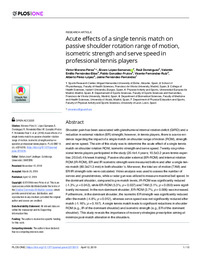Título :
Acute effects of a single tennis match on passive shoulder rotation range of motion, isometric strength and serve speed in professional tennis players |
Autor :
Moreno-Pérez, Victor
López-Samanes, Álvaro
Domínguez, Raúl
Fernández-Elías, Valentín Emilio
González-Frutos, Pablo 
FERNÁNDEZ RUIZ, VICENTE 
Pérez-López, Alberto 
Fernández-Fernandez, Jaime  |
Editor :
Public Library of Science |
Departamento:
Departamentos de la UMH::Patología y Cirugía |
Fecha de publicación:
2019-04-12 |
URI :
https://hdl.handle.net/11000/30692 |
Resumen :
Shoulder pain has been associated with glenohumeral internal rotation deficit (GIRD) and a reduction in external rotation (ER) strength; however, in tennis players, there is scarce evidence regarding the impact of a single match on shoulder range of motion (ROM), strength and serve speed. The aim of this study was to determine the acute effect of a single tennis match on shoulder rotation ROM, isometric strength and serve speed. Twenty-six professional tennis players participated in the study (20.4±4.4 years; 10.5±3.2 years tennis expertise; 20.5±5.4 h/week training). Passive shoulder external (ER-ROM) and internal rotation ROM (IR-ROM), ER and IR isometric strength were measured before and after a single tennis match (80.3±21.3 min) in both shoulder´s. Moreover, the total arc of motion (TAM) and ER/IR strength ratio were calculated. Video analysis was used to assess the number of serves and groundstrokes, while a radar gun was utilized to measure maximal ball speed. In the dominant shoulder, compared to pre-match levels, IR-ROM was significantly reduced
(-1.3%; p = 0.042), while ER-ROM (5.3%; p = 0.037) and TAM (3.1%; p = 0.050) were significantly increased. In the non-dominant shoulder, ER-ROM (3.7%; p = 0.006) was increased. Furthermore, in the dominant shoulder, the isometric ER strength was significantly reduced after the match (-4.8%; p = 0.012), whereas serve speed was not significantly reduced after match (-1.16%; p = 0.197). A single tennis match leads to significant reductions in shoulder ROM (e.g., IR of the dominant shoulder) and isometric strength (e.g., ER of the dominant
shoulder). This study reveals the importance of recovery strategies prescription aiming at minimize post-match alteration in the shoulders.
|
Tipo documento :
application/pdf |
Derechos de acceso:
info:eu-repo/semantics/openAccess
Attribution-NonCommercial-NoDerivatives 4.0 Internacional |
DOI :
htts://doi.org/10.1371/journal.pone.0215015 |
Aparece en las colecciones:
Artículos Patología y Cirugía
|
 La licencia se describe como: Atribución-NonComercial-NoDerivada 4.0 Internacional.
La licencia se describe como: Atribución-NonComercial-NoDerivada 4.0 Internacional.
.png)
